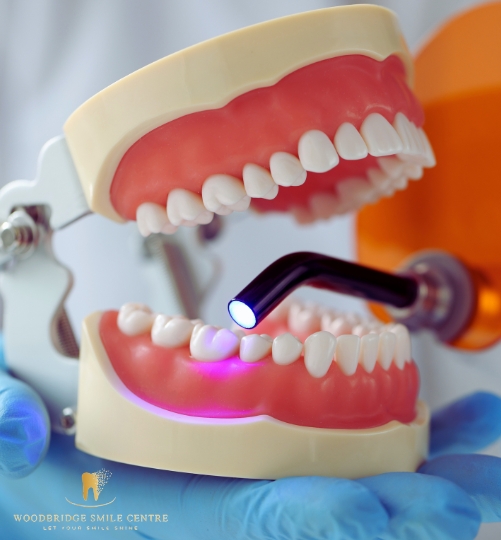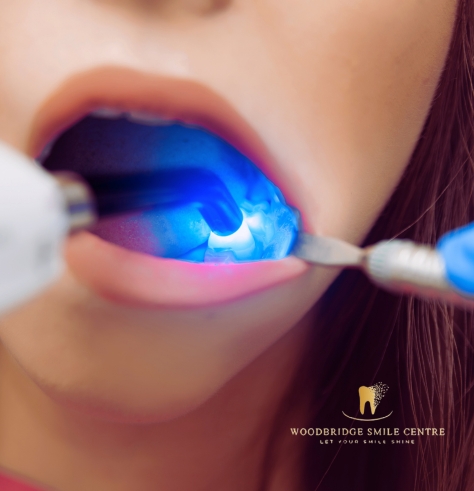Restorative Dentistry Woodbridge
Rediscovering your smile at Woodbridge Smile Centre.

Problems affecting your oral health and the beauty of your smile can be frustrating. Whether it’s cavities, missing teeth, or a chipped tooth, these issues hinder both our well-being and self-assurance.
Restorative Dentistry is a specialized field that is aimed at repairing or replacing teeth that are damaged or missing, which leads to overall oral health and improved aesthetics.
Explore the comprehensive restorative dental services offered at Woodbridge Smile Centre, addressing oral problems that affect the quality of your life. We stay up to date with the latest trends in restorative dentistry and use the most modern equipment for the best possible results. Our goal is to bring together expertise and comfort in one convenient location for the residents of Woodbridge.

Dental Fillings
A dental filling is a fundamental restorative dental procedure that is used to address cavities and decay in teeth. Through the procedure of dental filling, the tooth’s structure and function will be restored, preventing the progression of tooth decay. Untreated cavities will result in more serious dental problems, such as infections, abscesses, and even tooth loss.
The Most Common Cosmetic Dental Services
Procedure
- The Decayed Portion Is Removed: The dentist numbs the area by applying local anesthesia. Then, using a dental drill or laser, the dentist removes the decayed portion of the tooth.
- Filling Material Is Selected: Different materials are used for dental fillings depending on the location of the tooth, the extent of decay, and personal preferences. Commonly used materials are amalgam (a metal alloy), tooth-colored composite resin, porcelain, and glass ionomer.
- Filling Material Is Placed and Polished: The dentist shapes and molds the filling to match the shape of the tooth after the removal of the decayed part. Once the material is placed on the tooth, it is polished to ensure a smooth surface that doesn’t feel uncomfortable in the mouth and resembles the shape and color of the natural tooth.
Signs that Indicate You Need Dental Fillings
– You have persistent tooth pain, or your tooth is sensitive to hot or cold stimuli.
– You can see visible holes or pits on your tooth’s surface.
– Dark spots have appeared on your tooth.
– You experience discomfort while chewing or biting.
If you notice any of the above signs, schedule a visit to the dentist to evaluate your oral health and seek the required treatments to prevent further issues.
Dental Crowns
Dental crowns are caps that are placed on the tooth and cover them to restore the shape, size, strength, and overall appearance of the teeth that are damaged or weak because of various issues like tooth decay, fractures, or root canal treatment.
Dental crowns are commonly made of porcelain, ceramic, metal alloys, or a combination of materials.
Procedure
– The Tooth Is Prepared: The dentist removes the outer portion of the tooth to prepare it for accommodating the crown.
– Impressions Are Taken: Dental Crowns should match the shape of the space they would be placed on. So, the dentist takes an impression of your tooth to create a customized crown.
– A Temporary Crown Is Placed
– The Permanent Crown Is Placed: After the fabrication, the permanent crown is bonded onto the tooth.
When Do You Need Dental Crowns?
The following signs indicate that you may need dental crowns as your restorative treatment:
– Severe Tooth Decay and Large Cavities
– Root Canal Treatment
– Weak Teeth
– Teeth with Large Fillings
– Aesthetic Issues with Your Teeth
LET YOUR SMILE SHINE
Root Canal Treatment
Root canal treatment is a restorative dental procedure that aims at removing the damaged pulp from the inside of a tooth. Pulp is the soft tissue inside the tooth that contains nerves, blood vessels, and connective tissues. Severe tooth decay leads to the infection of the dental pulp, which consequently results in extreme pain and even tooth loss. Root canal treatment is performed to save the tooth from extraction by treating and removing the infection.
Procedure:
– Applying Local Anesthesia to Minimize Discomfort
– Making a Small Opening to Access the Pulp
– Removing the Infected Pulp
– Cleaning and Disinfecting the Root Canals
– Filling the Canals with a Biocompatible Material
– Sealing the Access Opening
When Do You Need Root Canal Treatment?
If you experience these signs, you might need root canal treatment:
– Extreme Pain in Your Tooth
– Tooth Sensitivity to Changes in Temperature or Applying Pressure
– Swelling in Your Gums
– Darkening of a Tooth

Dental Bridges
When you lose a tooth, a gap becomes noticeable between your teeth, and you lose the function and appearance of your natural tooth. In such situations, dental bridges become important to play the role of a replacement tooth that acts as the natural tooth. These prosthetic devices consist of artificial teeth or pontics, which are supported by crows on the adjacent natural teeth or dental implants.
Procedure
– Neighboring are prepared for dental crowns
– Impressions are taken to create a customized bridge
– The bridges are cemented into place after fabrication
Signs You Need Dental Bridges
– You have missing teeth
– You have difficulty in chewing or speaking
– You Notice Changes in Your Jaw Structure
Dental Implants
A dental implant is a structure that is designed to replace one or multiple missing teeth. A dental implant has three parts:
– Implant Post: An artificial tooth root, surgically placed inside the jawbone
– Implant Abutment: Connects the post to a prosthetic tooth
– Prosthetic Tooth: A dental crown, bridge, or denture which restores the appearance of a natural tooth
Procedure
– Placing the implant post inside the jawbone through a surgical operation by an implant specialist
– Osseointegration: Fusion of the implant post with bones. This stage typically takes several months.
– Abutment Placement
– Prosthetic Tooth Attachment
Signs You Need Dental Implants
– Missing Teeth
– Problems with Your Chewing or Speaking Caused by Tooth Loss
– Loose and Uncomfortable Dentures
– Changes in Facial Structure
– Tendency for A Lifelong Solution for Missing Teeth
LET YOUR SMILE SHINE
Dentures
Dentures are removable prosthetic teeth that are used for individuals who have lost several teeth. Dentures consist of Artificial teeth commonly made of acrylic resin and a base that supports the artificial teeth and rests on the gums. These prosthetic devices are held in place with clasps, suction, or dental adhesives.
Dentures come in two types, each serving a different purpose:
– Complete Dentures: Replace all teeth in the upper or lower jaw
– Partial Dentures: Replace some missing teeth. Partial dentures can be attached to adjacent natural teeth or dental implants.
When Do You Need Dentures?
Procedure
– Taking Impressions of the mouth to create dentures that fit precisely
– Fitting the Denture
– Adjustment after placement of denture to ensure maximized fit and comfort
Who Can Benefit from Dental Implants?
Individuals with the following issues can consider dentures as their restorative dental treatment:
- Loss of Several or All Teeth
- Difficulty Chewing or Speaking
- Pain and Sensitivity in the Gums Followed by Tooth Loss
- Tendency to Seek an Affordable Option for Tooth Replacement
FAQs About Restorative Dentistry
What are the common restorative dental procedures?
In the heart of Woodbridge, we offer comprehensive restorative dental procedures, including dental fillings, dental crowns, dental bridges, dental implants, and dentures. These treatments address issues like cavities, tooth decay, fractures, and tooth loss.
How do I know if I should seek restorative dental treatments?
Signs such as tooth pain, sensitivity, visible damage, or missing teeth may indicate a need for restorative dentistry. Regular dental check-ups can help identify issues early on.
Are restorative procedures painful?
Dentists use local anesthesia to ensure patients are comfortable during restorative procedures. At Woodbridge Smile Centre, our experienced dentists use optimized techniques and advanced technology to minimize discomfort.
What are the benefits of restorative dentistry?
Restorative dentistry improves oral health, restores function, enhances aesthetics, and prevents further dental problems. It helps maintain a natural-looking and fully functional smile.
Schedule Your Appointment Easily
If you encounter any tooth-related discomfort or notice any of the symptoms mentioned earlier, contact us promptly for a thorough assessment of your oral health and timely intervention. Throughout the years, our professional dentists at Woodbridge Smile Centre have successfully carried out numerous restorative treatments in Hamilton and gained invaluable experience in various dental fields. This experience and skill, combined with our innate compassion toward the patients, have made us a trusted destination for dental care in Hamilton. At Woodbridge Smile Centre, your oral well-being is our priority, and we aspire to contribute to the beauty and health of your smile.
Experience excellence in restorative dentistry in Hamilton. Call us now and book your appointment.
